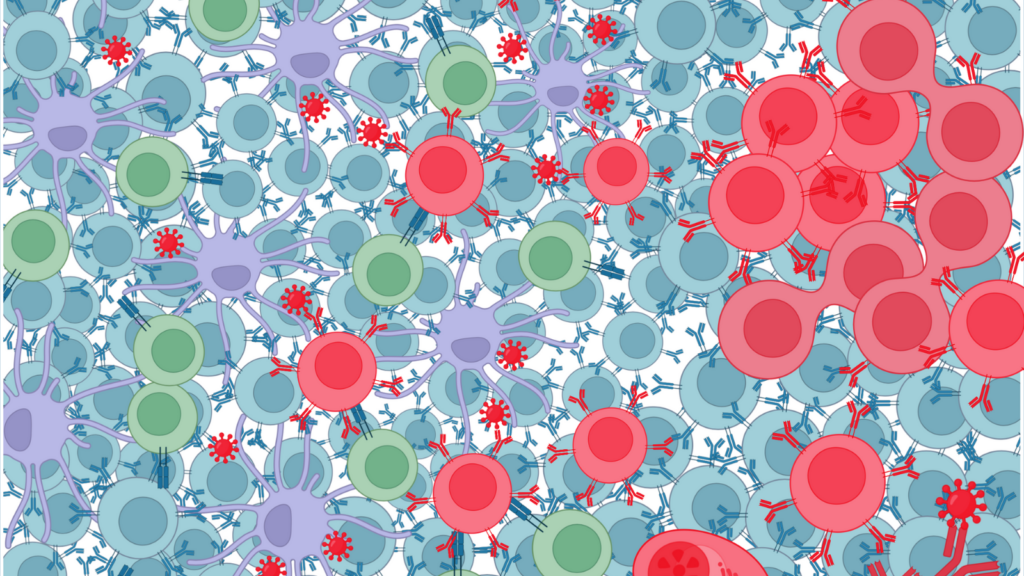June 18, 2024
Building better B cells: An interview with James Voss
Voss and his team are using gene editing technologies to reprogram B cells to make broadly neutralizing antibodies against HIV. Will this be a route to a functional cure?
By Kristen Kresge Abboud

The immune system can make antibodies against HIV. The problem is that most of them aren’t that effective at eliminating or neutralizing the virus. This is largely because HIV evolves so quickly that by the time the antibodies are around, the virus has already mutated enough to avoid neutralization. HIV is always a step ahead.
There are, however, a small minority of people living with HIV whose B cells make what are called broadly neutralizing antibodies, or bnAbs. These bnAbs are better at neutralizing many different viral variants, but they only rarely develop, and when they do, it is only after years of the virus’s persistent replication and mutation.
If you are a regular IAVI Report reader, then you already know that identification of these bnAbs unlocked many avenues of research and dominate the current efforts to prevent or cure HIV infection. Researchers are testing whether directly administering engineered bnAbs could protect against HIV infection or be part of a cure strategy and are also pursuing several multi-step strategies to try to engage and mature B cells to induce bnAbs through vaccination.
But HIV-specific bnAbs aren’t easy to induce. These antibodies are extensively mutated. Genetic limitations in the human B-cell antigen receptor (BCR) repertoire — which determines the diverse range of B cells that comprise an individual’s immune system — also limit the formation of HIV-specific bnAbs. This helps, in part, explain why these antibodies develop so rarely.

James Voss, an investigator in the Department of Immunology and Microbiology at Scripps Research in La Jolla, California, is trying to overcome this obstacle by using the gene editing technology known as CRISPR-Cas9 to expand the human B-cell repertoire by introducing mature bnAb genes into B cells. This modification means that these bnAb genes can be expressed as functional antigen receptors and therefore end up making the desired bnAb responses.
CRISPR-Cas9 was first described by two scientists, Jennifer Doudna and Emmanuelle Charpentier, who won the 2020 Nobel Prize in Chemistry for their work. The approach uses RNA to guide the Cas9 enzyme to a specific spot in the genome where it acts as molecular scissors, generating a double-stranded DNA break. This break triggers cellular DNA repair mechanisms that can be harnessed by scientists to specifically insert new DNA at the break site.
Voss’s group was the first to show that CRISPR-Cas9 could be used to successfully reprogram the specificity of B-cell antigen receptors. In subsequent studies, Voss and his team showed that vaccination could be used to guide these adoptively transferred reprogrammed B cells to undergo affinity maturation in germinal centers and eventually become the type of long-lived plasma cells that are capable of secreting the desired bnAbs in mice.
Voss’s work may still be in animal models but last year marked a big landmark for this type of gene editing in humans — the first CRISPR-based therapies were approved for treating sickle cell disease and beta thalassemia, an inherited blood disorder. In the coming years, the technology is expected to have far-reaching medical applications. Many CRISPR strategies are now in human clinical trials, including some intended to cure HIV infection by excising viral DNA from infected cells.
I recently spoke with Voss about his approach. An edited version of our conversation on this strategy and its potential to be a functional cure for HIV is below.
How did you begin working on using CRISPR to reprogram B cells against HIV?
It came from my time as a postdoc in Dennis Burton’s lab here at Scripps where I was working on the design of immunogens that might elicit protective bnAb responses. This was around the time when CRISPR and CAR T cells were showing serious promise and I started to become convinced that it would be easier to reprogram the B-cell receptor to express bnAbs using genome editing technologies than to get the B cells to do it through affinity maturation. I also wanted to forge a new pathway because I felt there were a lot of very bright people working on germline targeting and other approaches to elicit bnAbs from the natural B-cell repertoire. I wanted to diversify the strategies that were being pursued to solve the HIV problem.
It says a lot about germline targeting if you thought CRISPR was going to be an easier approach!
(Laughs). Well, these days the genome editing field is evolving so fast that it’s getting easier and easier. And if you imagine being able to eventually deliver your genome editing machinery to B cells in vivo using lipid nanoparticles at the same time as vaccine immunogens, then the end product could be as simple as getting a vaccine in your arm. This would be the ideal scenario and that’s what we’re working toward. I think the field is evolving so rapidly that we will be able to do these things on a much shorter timeline than we would’ve thought was possible previously.
Tell us a bit about how this works. How do you go about reprogramming the B-cell receptors?
What we are focused on right now is ex vivo targeting, which means we extract primary B cells, activate them in culture, and then introduce the engineering reagents to do precision editing. The technical side of this is that we insert a V-gene promoter, bnAb light chain, and its corresponding heavy chain variable region at a CRISPR-cut site upstream of the endogenous heavy chain constant region in the immunoglobulin (Ig)H-locus so that the new bnAb gene is expressed and spliced into the cells’ own IgH constant genes.
This insertion approach allows the bnAbs to be expressed as a functional BCR, allowing the cell to behave as it would normally. Then following vaccination, the cells with the modified BCR can signal antigen-dependent maturation programs that allow the cells to expand and enter germinal center reactions, where they can isotype switch and undergo somatic hypermutation. This process is what will also allow the bnAb to be secreted as an antibody after engineered cell differentiation to long-lived plasma cells, which is what we eventually want to happen.
Is it more difficult to engineer B-cell receptors compared to T-cell receptors, as it seems that the CAR T-cell work is further along?
Work on engineering B cells is behind T cells for a couple of main reasons. The first is that there was a delivery problem. For quite some time, engineered T cells could be transduced with lentiviruses and B cells couldn’t. We can now introduce reagents into primary B cells using nucleofection, AAV [adeno-associated virus] transduction, and newer pseudotyped lentiviral vectors.
The second reason is that a T-cell receptor does not need to undergo complicated genetic changes to result in a desired effector function. That means you can insert a T-cell antigen receptor expression cassette non-specifically into the genome and get the function you need from the modified cell that expresses it as a cell surface receptor.
It’s a little different with B cells. If, for example, we just put an antibody gene cassette into the B cell’s genome, it doesn’t work that well because a resting or naïve B cell doesn’t make much antibody, and so you’re going to get just a tiny amount secreted from that cell. What we really need to harness is the antigen-dependent maturation program for B cells, and that requires us to do very specific genome editing of the IgH locus. Then we transfer these reprogrammed B cells back into the host and use a vaccine to trigger these reprogrammed cells to expand, go through germinal center maturation, and finally, at the end of the road, differentiate into long-lived plasma cells that secrete the bnAb that ultimately provides the effector function that you want. With B cells you have to go through this whole cell development pathway to get to the end product, which makes it more challenging.
In the mouse, we put the engineered cells in intravenously and then vaccinate recipient animals. In response to vaccination, the modified B cells go into germinal centers, expand, and class switch to become long-lived plasma cells that engraft into the bone marrow, which gives us stable bnAb titers. The most encouraging data we have right now shows that these engineered cells can provide durable engineered antibody that remain at concentrations we think we need for suppression of viremia in an infected person by the best CD4-binding site antibodies. We’ve also shown that we can use the same vaccine to boost animals again to get even higher bnAb titers.
An advantage of using the vaccine is that we can engineer far fewer cells and still achieve the effect we want. For this mouse experiment, we gave mice only 80,000 engineered cells each, which is a small number compared to what is normally required for CAR T-cell therapy, for example.
Is this approach something you see as being used for prevention or only to try to achieve a functional cure?
I think at this stage it’s unreasonable to imagine engineering your genome or providing a very expensive cell therapy for prevention. I think the fact that we can suppress viremia with bnAbs is an onus for developing this as a functional cure approach. I think the technology will evolve to the point where we can eventually have a vaccine that both delivers the B-cell engineering payload and primes engineered cells. That’s where I’d like to see this technology go for it to eventually become widely accessible, first as a cure, but maybe eventually as a preventative measure down the road.
What are the next steps?
Well, first we are trying to understand why the MD39 ferritin vaccine immunogen we are using in mice provides the highest bnAb titers after vaccination. Then we also need to get the system to work well with other desired bnAb genes and in non-human primates [NHPs]. In our first NHP experiment, we found that it was possible to get the engineered cells to respond to a subcutaneous vaccination, which was very encouraging. We only injected a million engineered B cells intravenously into 10-12kg animals, partly because it was hard to make more cells than that, and so we were impressed that it was possible to engage the engineered cells so well with our vaccine immunogen. However, the bnAb titers were transient, so it’s not the big win we were hoping for. There’s still work to do to achieve stable, long-lasting antibody titers before we can think about advancing this approach into human clinical trials.
Do you foresee having to engineer B cells with genes from multiple different bnAbs with different specificities to achieve a functional cure?
I think it may be possible to do it with just one really broad and potent CD4-binding site antibody, but I think the safest bet, of course, is to elicit two or three bnAbs that target different epitopes for better coverage and protection against all the virus that could emerge from the latent reservoir.
Read more: